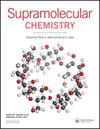(自我)汇编新闻:超分子化学文献的最新亮点(2023年第1季度)
IF 2.6
4区 化学
Q3 CHEMISTRY, MULTIDISCIPLINARY
引用次数: 0
摘要
柱[n]芳烃大环的合成是近年来超分子化学史上最具影响力的发展之一。这些大环具有丰富的主客体化学性质,通常可以在一个步骤中制备。由Andrew Sue(2021年Sessler早期职业研究奖得主)领导的团队在Nature Synthesis上发表的文章表明,柱[5]芳烃衍生物可用于形成定义良好的手性纳米管[1]。纳米管是由五甲酰基大环和苯二胺的单步缩合反应形成的(图1)。该五甲酰基化合物先前由同一小组报道,由冠状[5]芳烃合成,冠状[5]芳烃本身是由未分化柱状[5]芳烃[2]制备的。柱[5]芳烃是手性的,但通过环的旋转在溶液中迅速外消旋;然而,在纳米管中,这种旋转是锁定的,形成了一对可以用手性高效液相色谱分离的对映体管。虽然没有研究手性客体的结合,但纳米管对二羟基烷烃和二溴烷烃的结合表现出很强的选择性,并基于客体的大小。本文章由计算机程序翻译,如有差异,请以英文原文为准。
(Self) assembled news: recent highlights from the supramolecular chemistry literature (Quarter 1, 2023)
The synthesis of pillar[n]arene macrocycles has been one of the most influential developments in the recent history of supramolecular chemistry. These macrocycles have a rich host – guest chemistry and can often be prepared in a single step. Writing in Nature Synthesis, a team led by Andrew Sue (winner of the 2021 Sessler Early Career Research Prize) have shown that pillar[5] arene derivatives can be used to form well-defined chiral nanotubes [1]. The nanotubes are formed in a singlestep condensation reaction of a penta-formyl macrocycle and phenylenediamine in quantitative yield (Figure 1). The penta-formyl compound was previously reported by the same group and was synthesised from tiara[5]arene, which was itself prepared from a rimdifferentiated pillar[5]arene [2]. Pillar[5]arenes are chiral but racemise rapidly in solution through rotation of the rings; however, in the nanotubes this rotation is locked and a pair of enantiomeric tubes were formed that could be separated using chiral HPLC. While the binding of chiral guests was not investigated, the nanotubes show strong binding of dihydroxyalkanes and dibromoalkanes with selectivity based on guest size.
求助全文
通过发布文献求助,成功后即可免费获取论文全文。
去求助
来源期刊

Supramolecular Chemistry
化学-化学综合
CiteScore
3.60
自引率
3.00%
发文量
5
审稿时长
2.7 months
期刊介绍:
Supramolecular Chemistry welcomes manuscripts from the fields and sub-disciplines related to supramolecular chemistry and non-covalent interactions. From host-guest chemistry, self-assembly and systems chemistry, through materials chemistry and biochemical systems, we interpret supramolecular chemistry in the broadest possible sense. Interdisciplinary manuscripts are particularly encouraged. Manuscript types include: high priority communications; full papers; reviews, and; Methods papers, techniques tutorials highlighting procedures and technologies that are important to the field. We aim to publish papers in a timely fashion and as soon as a paper has been accepted and typeset it will be published in electronic form on the Latest articles section of the website. The two most important review criteria are that the paper presents high-quality work that fits generally into the broad spectrum of activities in the supramolecular chemistry field. Under normal circumstances, Supramolecular Chemistry does not consider manuscripts that would be more suitable in a highly specialized journal. This includes, but is not limited to, those based mostly or exclusively on topics such as solid state/X-ray structures, computational chemistry, or electrochemistry. .
The two most important review criteria are that the paper presents high-quality work that fits generally into the broad spectrum of activities in the supramolecular chemistry field.
 求助内容:
求助内容: 应助结果提醒方式:
应助结果提醒方式:


